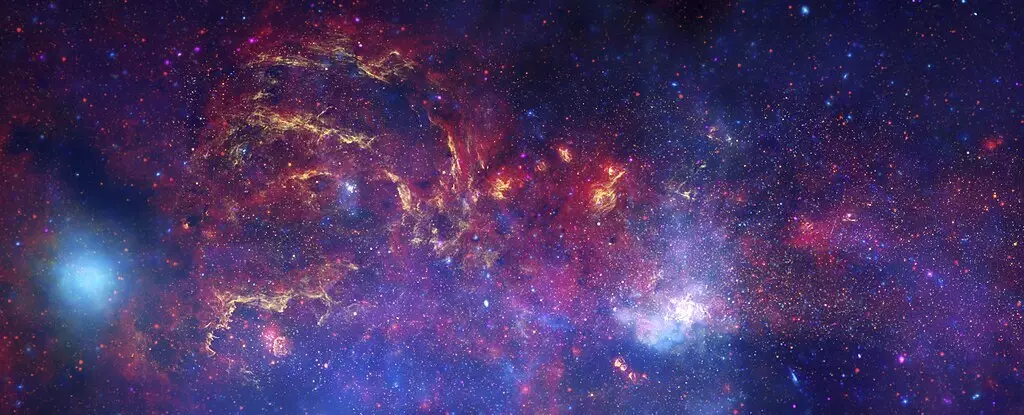Dark matter remains one of the most perplexing enigmas in modern physics. Observable only through its gravitational influence, it composes a staggering 85 percent of the universe’s mass, yet its true nature eludes direct detection. Recent research led by theoretical physicist Shyam Balaji from King’s College London points to the Central Molecular Zone (CMZ) of the Milky Way as a potential source of insights into this elusive substance. By scrutinizing the interactions within this unique region, scientists are not only challenging existing theories but also opening the door to new possibilities regarding the composition of dark matter itself.
Understanding dark matter is crucial for a comprehensive view of cosmic evolution. While researchers have predominantly focused on weakly interacting massive particles (WIMPs) as the primary candidates for dark matter, a paradigm shift may be on the horizon. The complexities of the CMZ, marked by its dense hydrogen gas and unusual positively charged clouds, suggest that the reality of dark matter may be far more intricate than previously believed.
The Role of the Central Molecular Zone
The Central Molecular Zone, situated at the heart of our galaxy, is a fascinating area characterized by its dense collections of hydrogen molecules. These dense molecular clouds not only serve as star-forming regions but also represent a turbulent environment where energetic processes occur at extraordinary rates. The region’s peculiarities, such as the detection of positively charged hydrogen, raise questions about the forces at play in this area, specifically regarding what could be stripping electrons from hydrogen molecules.
Balaji’s research sheds light on this mystery, suggesting that the interaction of dark matter may indeed be contributing to these anomalous occurrences. While conventional understanding points to cosmic rays as potential ionization sources, the evidence gathered from the CMZ seems to lean in a different direction. The energy signatures observed are too faint to correlate with cosmic rays and indicate that the source of ionization might be something fundamentally different—perhaps linked to a lighter, as-yet-undiscovered form of dark matter.
Reconsidering Dark Matter Candidates
The current discourse surrounding dark matter candidates is undergoing a significant transformation. Traditional approaches have dominated the scientific landscape for decades, focusing heavily on WIMPs and their elusive interactions. However, Balaji and his collaborators argue for a broader investigation that encompasses a spectrum of possible particles, including those lighter than WIMPs. Such a shift in perspective could illuminate pathways to understanding phenomena like the anomalous charge in the CMZ’s molecular clouds.
A lighter dark matter particle may possess attributes that facilitate its interaction with the ordinary matter surrounding us. In fact, the suggestion that these particles might annihilate, resulting in oppositely charged particles capable of ionizing hydrogen, offers a promising avenue for research. If validated, these findings could unravel the ways in which dark matter interacts, revolutionizing our understanding of both the universe and the fundamental forces at work within it.
An Invitation for Wider Exploration
The implications of the new research extend far beyond the confines of the Central Molecular Zone. They challenge scientists to cast a wider net in the search for dark matter, urging a departure from the narrow focus on WIMPs. This call for a more inclusive investigation resonates across the scientific community, as it promises to explore not only the potential of lighter dark matter candidates but also the existence of other phenomena that may yet be unknown.
As the quest for dark matter continues, it is vital to foster an environment that encourages innovative thinking and experimentation. Balaji emphasizes that many approaches are grounded on Earth, essentially waiting for dark matter to make itself known. However, the evidence from the CMZ indicates that our focus should instead be directed towards the depths of space, where dark matter is not merely an abstract concept but a tangible force reshaping cosmic structures.
The Promising Horizon of Cosmological Research
As researchers like Balaji forge ahead in their investigations, the horizon of cosmological research becomes increasingly exciting. The revelations emerging from the Central Molecular Zone are not just academic curiosities; they represent potential breakthroughs that could redefine our grasp of the universe. They illuminate the need for interdisciplinary collaboration and adaptive methodologies capable of meeting the complexities of dark matter head-on.
Although still speculative, the prospects suggested by this study could pave the way for a more profound understanding of both dark matter and the foundational elements of our universe. Recognizing the intricacies involved is crucial, and the quest for knowledge continues to fuel scientific inquiry. The inquiry into dark matter is far from over, and as investigations evolve, they may eventually lead us to unlock the deepest secrets of the cosmos.

